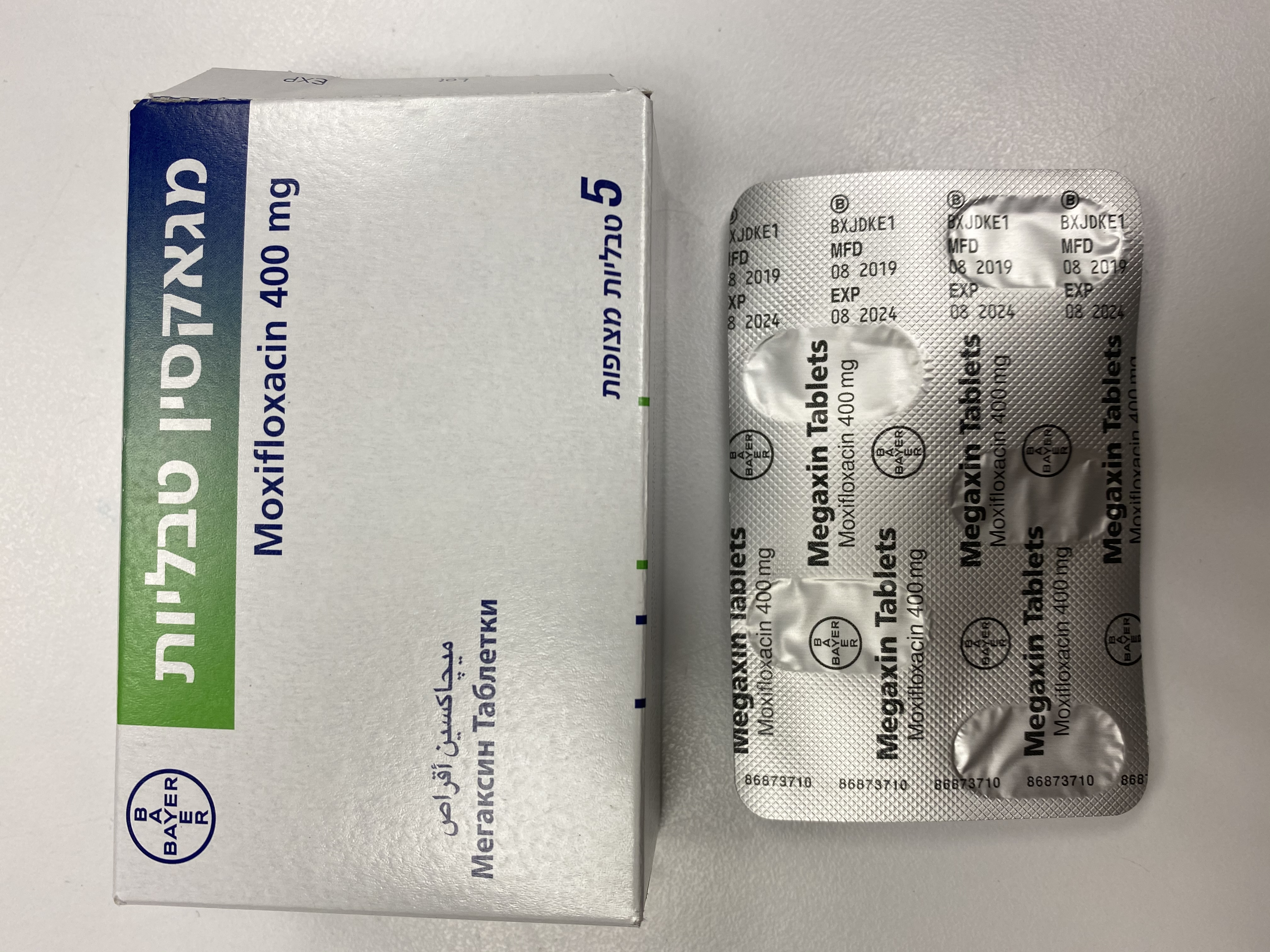Quest for the right Drug

מגאקסין טבליות MEGAXIN TABLETS (MOXIFLOXACIN AS HYDROCHLORIDE)
תרופה במרשם
תרופה בסל
נרקוטיקה
ציטוטוקסיקה
צורת מתן:
פומי : PER OS
צורת מינון:
טבליות מצופות פילם : FILM COATED TABLETS
עלון לרופא
מינוניםPosology התוויות
Indications תופעות לוואי
Adverse reactions התוויות נגד
Contraindications אינטראקציות
Interactions מינון יתר
Overdose הריון/הנקה
Pregnancy & Lactation אוכלוסיות מיוחדות
Special populations תכונות פרמקולוגיות
Pharmacological properties מידע רוקחי
Pharmaceutical particulars אזהרת שימוש
Special Warning עלון לרופא
Physicians Leaflet
Interactions : אינטראקציות
4.5 Interaction with other medicinal products and other forms of interaction Interactions with medicinal products An additive effect on QT interval prolongation of moxifloxacin and other medicinal products that may prolong the QTc interval cannot be excluded. This might lead to an increased risk of ventricular arrhythmias, including torsade de pointes. Therefore, co-administration of moxifloxacin with any of the following medicinal products is contraindicated (see also section 4.3): - anti-arrhythmics class IA (e.g. quinidine, hydroquinidine, disopyramide) - anti-arrhythmics class III (e.g. amiodarone, sotalol, dofetilide, ibutilide) - antipsychotics (e.g. phenothiazines, pimozide, sertindole, haloperidol, sultopride) - tricyclic antidepressive agents - certain antimicrobial agents (saquinavir, sparfloxacin, erythromycin IV, pentamidine, antimalarials particularly halofantrine) - certain antihistaminics (terfenadine, astemizole, mizolastine) - others (cisapride, vincamine IV, bepridil, diphemanil). Moxifloxacin should be used with caution in patients who are taking medication that can reduce potassium levels (e.g. loop and thiazide-type diuretics, laxatives and enemas [high doses], corticosteroids, amphotericin B) or medication that is associated with clinically significant bradycardia. For tablets only: An interval of about 6 hours should be left between administration of agents containing bivalent or trivalent cations (e.g. antacids containing magnesium or aluminium, didanosine tablets, sucralfate and agents containing iron or zinc) and administration of moxifloxacin. Concomitant administration of charcoal with an oral dose of 400 mg moxifloxacin led to a pronounced prevention of drug absorption and a reduced systemic availability of the drug by more than 80%. Therefore, the concomitant use of these two drugs is not recommended (except for overdose cases, see also section 4.9). For IV and tablets: After repeated dosing in healthy volunteers, moxifloxacin increased Cmax of digoxin by approximately 30% without affecting AUC or trough levels. No precaution is required for use with digoxin. In studies conducted in diabetic volunteers, concomitant administration of oral moxifloxacin with glibenclamide resulted in a decrease of approximately 21% in the peak plasma concentrations of glibenclamide. The combination of glibenclamide and moxifloxacin could theoretically result in a mild and transient hyperglycaemia. However, the observed pharmacokinetic changes for glibenclamide did not result in changes of the pharmacodynamic parameters (blood glucose, insulin). Therefore no clinically relevant interaction was observed between moxifloxacin and glibenclamide. Changes in INR A large number of cases showing an increase in oral anticoagulant activity have been reported in patients receiving antibacterial agents, especially fluoroquinolones, macrolides, tetracyclines, cotrimoxazole and some cephalosporins. The infectious and inflammatory conditions, age and general status of the patient appear to be risk factors. Under these circumstances, it is difficult to evaluate whether the infection or the treatment caused the INR (international normalised ratio) disorder. A precautionary measure would be to more frequently monitor the INR. If necessary, the oral anticoagulant dosage should be adjusted as appropriate. Clinical studies have shown no interactions following concomitant administration of moxifloxacin with: ranitidine, probenecid, oral contraceptives, calcium supplements, morphine administered parenterally, theophylline, cyclosporine or itraconazole. In vitro studies with human cytochrome P450 enzymes supported these findings. Considering these results a metabolic interaction via cytochrome P450 enzymes is unlikely. Interaction with food Moxifloxacin has no clinically relevant interaction with food including dairy products.

שימוש לפי פנקס קופ''ח כללית 1994
לא צוין
תאריך הכללה מקורי בסל
לא צוין
הגבלות
לא צוין
מידע נוסף
עלון מידע לצרכן
24.08.14 - עלון לצרכן 10.03.22 - עלון לצרכן אנגלית 08.05.22 - עלון לצרכן עברית 10.03.22 - עלון לצרכן ערבית 06.11.22 - עלון לצרכן אנגלית 06.11.22 - עלון לצרכן עברית 06.11.22 - עלון לצרכן ערבית 11.06.23 - עלון לצרכן עברית 06.08.24 - עלון לצרכן עברית 20.03.14 - החמרה לעלון 24.08.14 - החמרה לעלון 29.12.16 - החמרה לעלון 25.07.19 - החמרה לעלון 23.02.20 - החמרה לעלון 14.06.20 - החמרה לעלון 05.10.20 - החמרה לעלון 31.03.21 - החמרה לעלון 23.09.21 - החמרה לעלון 08.05.22 - החמרה לעלוןלתרופה במאגר משרד הבריאות
מגאקסין טבליות